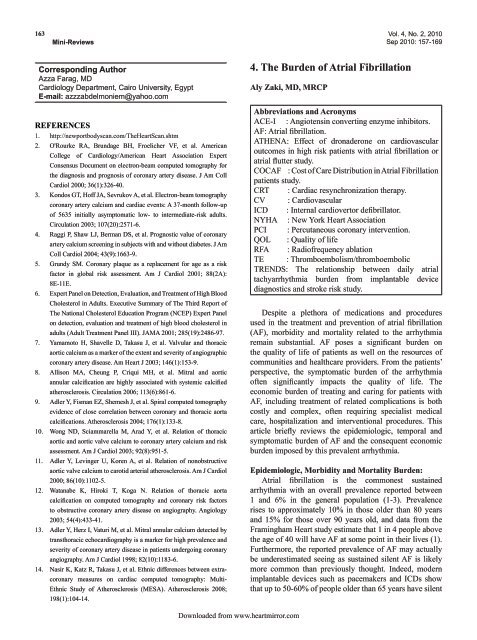Coronary Calcium Score Azza Farag, MD ... - HeartMirror.com
Coronary Calcium Score Azza Farag, MD ... - HeartMirror.com
Coronary Calcium Score Azza Farag, MD ... - HeartMirror.com
Create successful ePaper yourself
Turn your PDF publications into a flip-book with our unique Google optimized e-Paper software.
163<br />
Mini-Reviews<br />
Vol. 4, No. 2, 2010<br />
Sep 2010: 157-169<br />
Corresponding Author<br />
<strong>Azza</strong> <strong>Farag</strong>, <strong>MD</strong><br />
Cardiology Department, Cairo University, Egypt<br />
E-mail: azzzabdelmoniem@yahoo.<strong>com</strong><br />
REFERENCES<br />
1. http://newportbodyscan.<strong>com</strong>/TheHeartScan.shtm<br />
2. O'Rourke RA, Brundage BH, Froelicher VF, et al. American<br />
College of Cardiology/American Heart Association Expert<br />
Consensus Document on electron-beam <strong>com</strong>puted tomography for<br />
the diagnosis and prognosis of coronary artery disease. J Am Coll<br />
Cardiol 2000; 36(1):326-40.<br />
3. Kondos GT, Hoff JA, Sevrukov A, et al. Electron-beam tomography<br />
coronary artery calcium and cardiac events: A 37-month follow-up<br />
of 5635 initially asymptomatic low- to intermediate-risk adults.<br />
Circulation 2003; 107(20):2571-6.<br />
4. Raggi P, Shaw LJ, Berman DS, et al. Prognostic value of coronary<br />
artery calcium screening in subjects with and without diabetes. J Am<br />
Coll Cardiol 2004; 43(9):1663-9.<br />
5. Grundy SM. <strong>Coronary</strong> plaque as a replacement for age as a risk<br />
factor in global risk assessment. Am J Cardiol 2001; 88(2A):<br />
8E-11E.<br />
6. Expert Panel on Detection, Evaluation, and Treatment of High Blood<br />
Cholesterol in Adults. Executive Summary of The Third Report of<br />
The National Cholesterol Education Program (NCEP) Expert Panel<br />
on detection, evaluation and treatment of high blood cholesterol in<br />
adults (Adult Treatment Panel III). JAMA 2001; 285(19):2486-97.<br />
7. Yamamoto H, Shavelle D, Takasu J, et al. Valvular and thoracic<br />
aortic calcium as a marker of the extent and severity of angiographic<br />
coronary artery disease. Am Heart J 2003; 146(1):153-9.<br />
8. Allison MA, Cheung P, Criqui MH, et al. Mitral and aortic<br />
annular calcification are highly associated with systemic calcified<br />
atherosclerosis. Circulation 2006; 113(6):861-6.<br />
9. Adler Y, Fisman EZ, Shemesh J, et al. Spiral <strong>com</strong>puted tomography<br />
evidence of close correlation between coronary and thoracic aorta<br />
calcifications. Atherosclerosis 2004; 176(1):133-8.<br />
10. Wong ND, Sciammarella M, Arad Y, et al. Relation of thoracic<br />
aortic and aortic valve calcium to coronary artery calcium and risk<br />
assessment. Am J Cardiol 2003; 92(8):951-5.<br />
11. Adler Y, Levinger U, Koren A, et al. Relation of nonobstructive<br />
aortic valve calcium to carotid arterial atherosclerosis. Am J Cardiol<br />
2000; 86(10):1102-5.<br />
12. Watanabe K, Hiroki T, Koga N. Relation of thoracic aorta<br />
calcification on <strong>com</strong>puted tomography and coronary risk factors<br />
to obstructive coronary artery disease on angiography. Angiology<br />
2003; 54(4):433-41.<br />
13. Adler Y, Herz I, Vaturi M, et al. Mitral annular calcium detected by<br />
transthoracic echocardiography is a marker for high prevalence and<br />
severity of coronary artery disease in patients undergoing coronary<br />
angiography. Am J Cardiol 1998; 82(10):1183-6.<br />
14. Nasir K, Katz R, Takasu J, et al. Ethnic differences between extracoronary<br />
measures on cardiac <strong>com</strong>puted tomography: Multi-<br />
Ethnic Study of Atherosclerosis (MESA). Atherosclerosis 2008;<br />
198(1):104-14.<br />
4. The Burden of Atrial Fibrillation<br />
Aly Zaki, <strong>MD</strong>, MRCP<br />
Abbreviations and Acronyms<br />
ACE-I : Angiotensin converting enzyme inhibitors.<br />
AF: Atrial fibrillation.<br />
ATHENA: Effect of dronaderone on cardiovascular<br />
out<strong>com</strong>es in high risk patients with atrial fibrillation or<br />
atrial flutter study.<br />
COCAF : Cost of Care Distribution in Atrial Fibrillation<br />
patients study.<br />
CRT : Cardiac resynchronization therapy.<br />
CV : Cardiovascular<br />
ICD : Internal cardiovertor defibrillator.<br />
NYHA : New York Heart Association<br />
PCI : Percutaneous coronary intervention.<br />
QOL : Quality of life<br />
RFA : Radiofrequency ablation<br />
TE : Thromboembolism/thromboembolic<br />
TRENDS: The relationship between daily atrial<br />
tachyarrhythmia burden from implantable device<br />
diagnostics and stroke risk study.<br />
Despite a plethora of medications and procedures<br />
used in the treatment and prevention of atrial fibrillation<br />
(AF), morbidity and mortality related to the arrhythmia<br />
remain substantial. AF poses a significant burden on<br />
the quality of life of patients as well on the resources of<br />
<strong>com</strong>munities and healthcare providers. From the patients’<br />
perspective, the symptomatic burden of the arrhythmia<br />
often significantly impacts the quality of life. The<br />
economic burden of treating and caring for patients with<br />
AF, including treatment of related <strong>com</strong>plications is both<br />
costly and <strong>com</strong>plex, often requiring specialist medical<br />
care, hospitalization and interventional procedures. This<br />
article briefly reviews the epidemiologic, temporal and<br />
symptomatic burden of AF and the consequent economic<br />
burden imposed by this prevalent arrhythmia.<br />
Epidemiologic, Morbidity and Mortality Burden:<br />
Atrial fibrillation is the <strong>com</strong>monest sustained<br />
arrhythmia with an overall prevalence reported between<br />
1 and 6% in the general population (1-3). Prevalence<br />
rises to approximately 10% in those older than 80 years<br />
and 15% for those over 90 years old, and data from the<br />
Framingham Heart study estimate that 1 in 4 people above<br />
the age of 40 will have AF at some point in their lives (1).<br />
Furthermore, the reported prevalence of AF may actually<br />
be underestimated seeing as sustained silent AF is likely<br />
more <strong>com</strong>mon than previously thought. Indeed, modern<br />
implantable devices such as pacemakers and ICDs show<br />
that up to 50-60% of people older than 65 years have silent<br />
Downloaded from www.heartmirror.<strong>com</strong>



